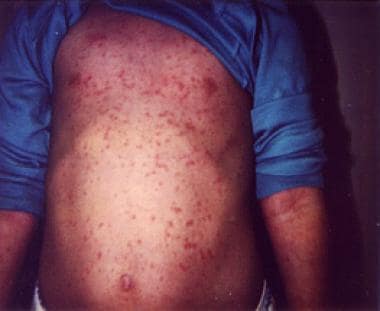Practice Essentials
Rubella is now rare because of widespread compliance with childhood immunization programs. [1] The disease is usually a benign and inconsequential viral illness unless exposure occurs in utero.
Rubella is caused by a single-stranded RNA togavirus.
Congenital rubella syndrome is associated with clinically significant congenital malformations. [2] The live-attenuated virus vaccine has decreased the incidence of rubella significantly, thereby decreasing congenital disease. See the image below.
 Image in a 4-year-old girl with a 4-day history of low-grade fever, symptoms of an upper respiratory tract infection, and rash. Courtesy of Pamela L. Dyne, MD.
Image in a 4-year-old girl with a 4-day history of low-grade fever, symptoms of an upper respiratory tract infection, and rash. Courtesy of Pamela L. Dyne, MD.
Pathophysiology
The causative organism is a single-stranded RNA togavirus that is transmitted by means of respiratory droplets. The virus replicates in the nasopharynx and regional lymph nodes, resulting in viremia. The virus then may spread to the skin, CNS, synovial fluid, and transplacentally to a developing fetus.
Epidemiology
United States statistics
Before the rubella vaccination became available in 1969, epidemics occurred every 6-9 years and pandemics every 10-20 years. In 1977-1981, 20,395 cases of rubella were reported in the United States. According to Statistical Handbook on Infectious Disease regarding historical trends of rubella in the United States, the incidence has significantly decreased since that time. [3] In 1990, 1124 cases of rubella occurred, and, in 1999, only 267 occurred. In the last decade, the rate has been less than 10 cases of congenital rubella syndrome per year. These cases mostly affected mothers born outside of the United States in Latin American countries with lower vaccination rates.
In 2004, the Centers for Disease Control and Prevention (CDC) reported that, since 2001, fewer than 25 cases of rubella have occurred each year in the United States. [4] The CDC estimates 95% vaccination coverage among school-aged children and 91% immunity in the population. [4]
During the 1990s resistance to the MMR vaccine developed. An earlier (since discontinued) version in the United Kingdom was associated with aseptic meningitis. As a result of this, vaccination rates in the United Kingdom fell from an earlier level of 92% to 79% in 1998; they have since rebounded. [5] Moreover, a correlation between autism and MMR use was later postulated. Subsequent epidemiologic studies have shown no significant association between the vaccine and either condition. Inadequate vaccination rates have led to an ongoing outbreak in Austria. [6]
A recent case control study, presuming it to be a random variation, found a correlation between early rubella vaccination (before age 10) and later development of multiple sclerosis. [7] Another recent study shows that immigrant women in Canada had surprisingly low vaccination rates; this highlights the risk of epidemics in areas with significant immigrant populations. [8] Vaccination rates remain very high in the United States; should this change in the future, the frequency of rubella could change dramatically.
From 2000 to 2012, rising numbers of WHO member states began using rubella-containing vaccines (RCVs) in their immunization program and began reporting rubella and congenital rubella syndrome (CRS) surveillance data. As of December 2012, 132 (68%) WHO member states had introduced RCV, a 33% increase from 99 member states in 2000. Some 43% of infants had received a RCV dose in 2012, a 96% increase from the 22% of infants who had been vaccinated against rubella in 2000. A total of 94,030 rubella cases were reported to WHO in 2012 from 174 member states, an 86% decrease from the 670,894 cases reported in 2000 from 102 member states. [9, 10]
International statistics
The rubella vaccination is given to only about half the world's population. Congenital rubella syndrome remains a major problem in some areas. In Russia, for instance, congenital rubella syndrome causes 15% of all birth defects.
Global rubella vaccine coverage was reported to be 70% in 2020. [1] About 100,000 cases of congenital rubella syndrome are estimated to occur each year in low- and middle-income countries. [11]
Race-, sex-, and age-related demographics
The highest risk is among members of racial or ethnic groups who are unvaccinated and who may be exposed to persons traveling from areas where rubella vaccination is not routine.
Recent outbreaks have occurred among persons of Hispanic ethnicity. Consequently, Hispanic persons and persons from countries without rubella vaccination programs should be considered susceptible to rubella unless they have documentation of vaccination or serologic evidence of immunity.
Rubella affects men and women equally.
Before vaccination, the peak incidence occurred in children aged 5-14 years. However, at present, most cases occur in teenagers or young adults.
Prognosis
Beyond the fetal period, rubella is generally benign and self-limiting and without complications.
Infants born with congenital rubella syndrome may have a variety of complications; therefore, their prognosis depends on the severity of their malformations.
Morbidity/mortality
Infection in healthy children or young adults is generally self-limited and without sequelae.
The most common complications are arthropathies of the fingers, wrists, and knees that can persist for a year or more.
Thrombocytopenia with purpura and hemorrhage is a rare complication of rubella.
Congenital rubella syndrome is associated with malformations of multiple organ systems including the CNS and cardiac, ocular, and skeletal systems. Infants with congenital rubella syndrome who survive into adulthood may be plagued by autoimmune disorders and dysgammaglobulinemia.
Damage to the fetus is most likely when maternal infection occurs during the first 2 months of pregnancy, although there is risk associated with infection up to 5 months.
Patient Education
Reinforcement of scheduled routine immunizations is imperative.
For helpful patient education resources, visit eMedicineHealth's Children's Health Center and Infections Center. Also, see eMedicineHealth's patient education articles Measles; Skin Rashes in Children; and Immunization Schedule, Children.
-
Image in a 4-year-old girl with a 4-day history of low-grade fever, symptoms of an upper respiratory tract infection, and rash. Courtesy of Pamela L. Dyne, MD.






